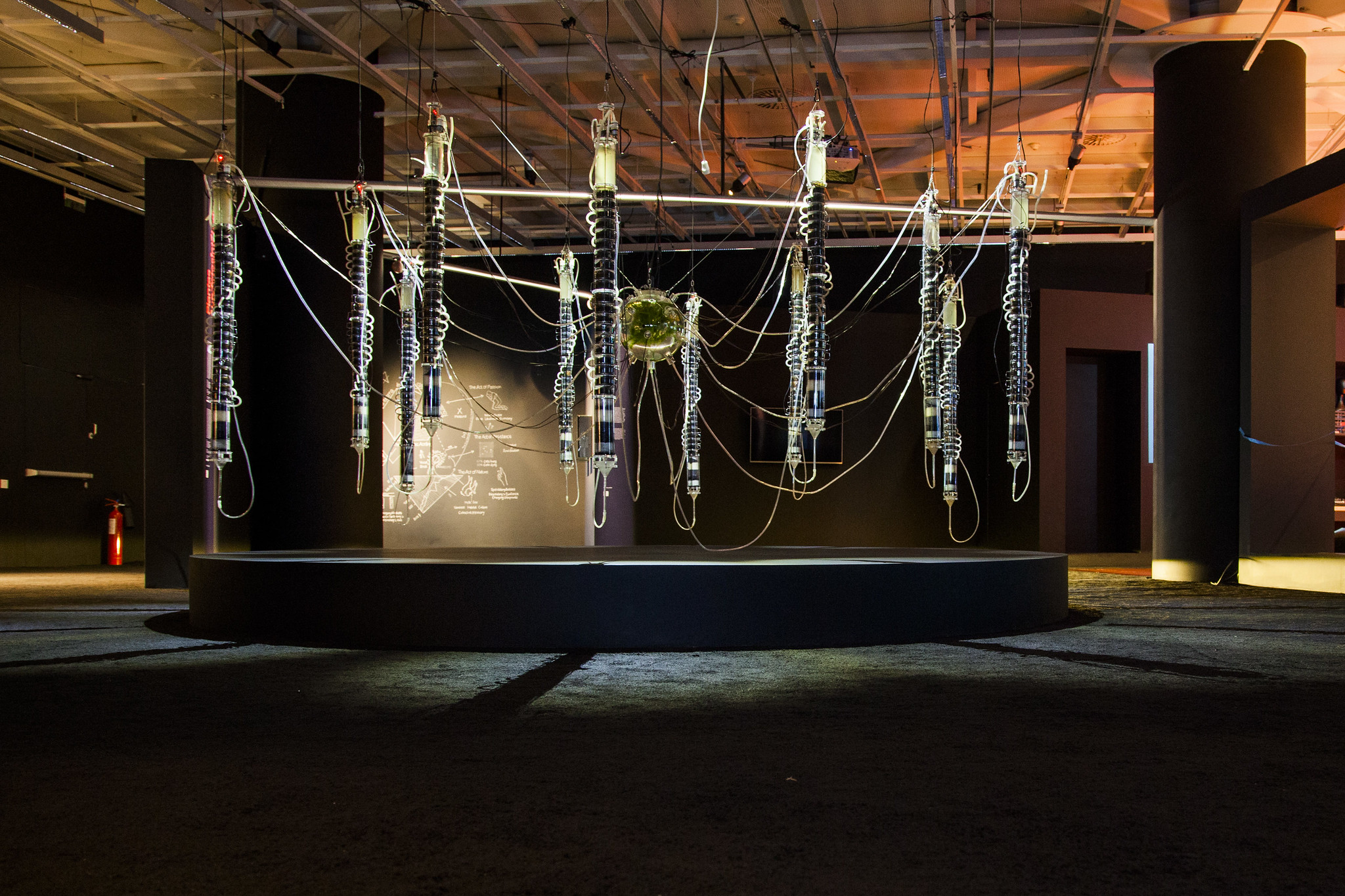This is the first comprehensive exhibition that Ars Electronica Linz has ever staged to showcase artistic positions on this very timely topic. HYBRIDS, designed in collaboration with the Onassis Cultural Centre-Athens, features 16 extraordinary manifestations of artistic considerations, positions and processes, artifacts and works, workshops and presentations—hybrids one and all. Hybrid also applies to the exhibition setting, an attempt to create a space that facilitates experiencing precisely these phenomena, one that effectively displays works, enables working processes and permits participation, and thereby fosters a joint endeavor to gain a better understanding of our world.
Type: Exhibition
Duration: November 7, 2016 – January 15, 2017
City, Country: Athens, Greece
Venue: Onassis Cultural Centre Athens, Greece
“Nobody knows what it’s all about. You can’t look to authors of the past to ascertain where things will be headed in the future. On this matter, Hegel has nothing to say—after all, you can’t trust people who never even used a telephone. The simultaneity that we have now, this is totally new.”
Robert Adrian X
When we speak of “hybrid” and “hybrid works” in conjunction with this exhibition, then we can generally describe what we mean in terms of interdisciplinarity and remix, that which is processual and simultaneous. More profound consideration of the works reveals three categories: Hybrid Realities focuses, first and foremost, on the simultaneity of systems; Mankind & Utopia investigates the nexus of art and science; and Hybrid remixed features the forms of social critique that emerge when art goes angling in foreign waters and hosts the odd meet & greet of elements that rarely get together for such encounters.

So, what does it mean if art enters into a liaison with other disciplines? When artists with no qualms about dealing with non-artists do things like scrutinize scientific experiments, delve into other markets, or even instructively run a faux con game on the home turf of the business world’s profiteers? What are the contents of our understanding of artistic “works” and their spaces? What does collaboration mean in this context and what influence does it have on authorship? Don’t these new approaches also necessitate new definitions and taxonomies, or even a new language, and ultimately a new way of looking at our world?
“We’ve arrived at a point in time at which much of our cultural heritage has become untenable. A new age has dawned. And the problem with a paradigm shift is that the new paradigms require a new type of language. The old metaphors don’t work anymore.”
Robert Adrian X
The Prix Ars Electronica, a competition staged annually by Ars Electronica Linz, has included a Hybrid category since 2007. (Since 2013 the Golden Nica in the HYBRID category is awarded on a biennial basis.) The backstory: Insinuation into the world of Digital Art of more and more computer-supported artistic methods and artifacts that were of such a processual nature and took such a significantly interdisciplinary approach entailing other genres such as performance, theater, music, film, architecture and, most significantly, fields of the natural sciences, and which constituted noteworthy achievements but evaded attribution to the extant Prix categories. In Hybrid, the accent is on merging different media and genres into new forms of artistic expression, on crossing the boundaries between art and research, on social and political commitment and activism, as well as on reconnoitering pop cultural realms.
Artworks
Lauren McCarthy (US), Kyle McDonald (US)
Social Soul

Social Soul is an immersive digital experience inspired by the question: how does it feel to be inside someone else’s social media stream? Originally created for Delta Air Lines at TED2014 in collaboration with MKG, the installation brings to life a user’s Twitter stream in an immersive structure where their social media life is on display in a 360-degree stream of monitors, mirrors and sound. The experience starts with the stream of the person visiting, and then uses a custom algorithm to match participants with other visitors, displaying their social stream. After exiting, users and their connected “Soul Mate” receive a tweet encouraging offline connections and conversation. The entire project uses seven different languages of code to handle everything from scripting to styling. The sound is a mixture of generative audio and music composed in Live.
Paolo Cirio (IT/US)
Loophole for All
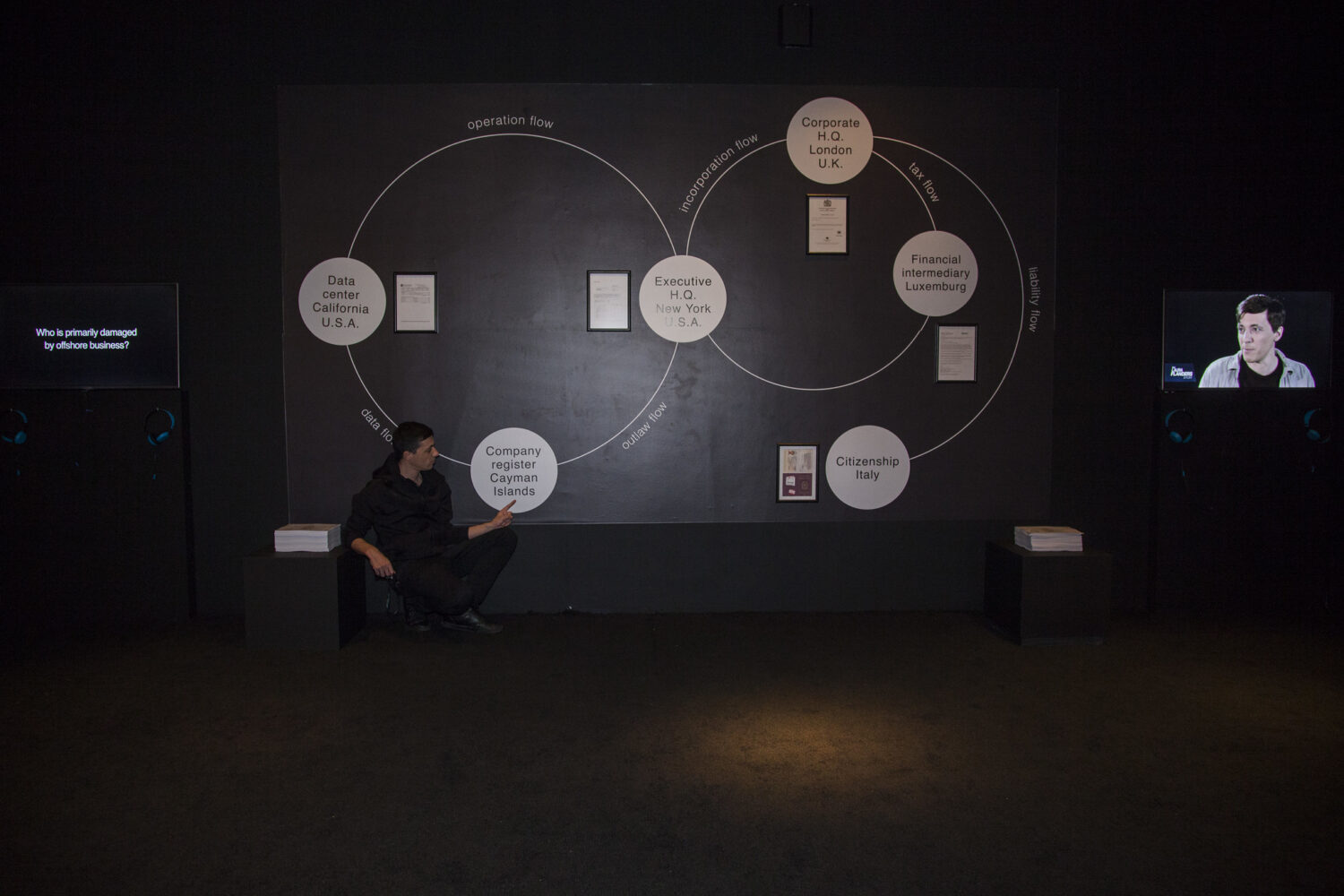
This artwork undermined the idea of having a company “on paper” in countries considered financial offshore centers. The artist unveiled over 200000 Cayman Islands companies and reversed global finance machination through conceptual art. The website Loophole4All.com promoted the sale of real identities of anonymous Cayman companies at low cost to democratize the privileges of offshore businesses by forging Certificates of Incorporation documents for each company, all issued with the artist’s real name and signature. This performance generated international media attention, engaged an active audience and drew outrage from authorities on the Cayman Islands, international law and accounting firms, PayPal, and real owners of the companies. Further, the artist interviewed major experts and produced a video documentary investigating offshore centers to expose their social costs and to envision solutions to global economic inequality. In the offline art installation, the paper trail of the project is displayed with prints of the counterfeited Certificates of Incorporation and the documents of the scheme set up for the operation.
Manu Luksch (AT)
Third Quarterly Report
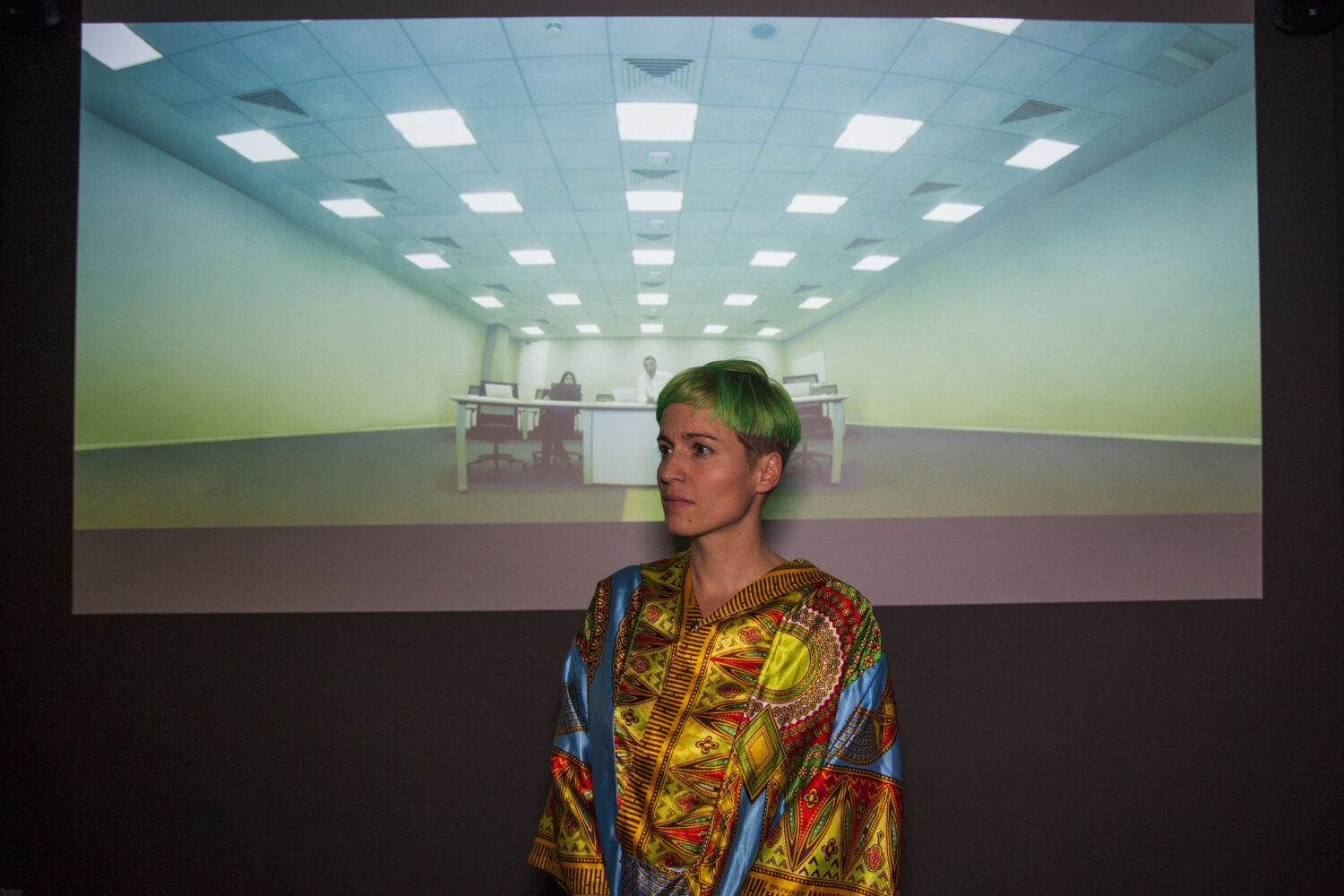
Out in the street the mercury touches 39°C. In the videoconference suite, the Managing Director keeps cool through reports of ‘top wins’ and ‘flat growth’. His global team is charged with designing tomorrow’s urbanism. “The Smart City market is about $12bn, growing 12.4% annually to reach around $27bn by 2023. That’s the size of this opportunity.” The proliferation of networked sensors and distributed processing – the ‘Internet of Things’ – makes possible a fully embedded information infrastructure, a ‘city operating system’. ‘Big Data’ from smartphones, buildings, transit networks, and vending machines is mined, traded, and used to predict future patterns. This ‘ambient information’ turns the ‘Smart’ or ‘Cognitive City’ into an agent, a narrative partner in collective life, with its own beliefs, judgments and preferences. Traffic flow and garbage management, crime prevention and epidemic control alike become amenable to algorithmic management. Questions arise – who are these makers of tomorrow’s urban fabric?
The film installation observes the 3Q report at Cisco Systems, as it leads the weaving together of data infrastructure and the built environment. Behind the quarterly sales figures and projections lie programs with immense transformative power over the new– programs whose long-term consequences deserve careful consideration.
produced by denkbar and Manu Luksch, immersive video/vfx developer Jack Wolf, additional camera Christian Haake, sound Mukul
James Bridle (UK)
A Ship Adrift
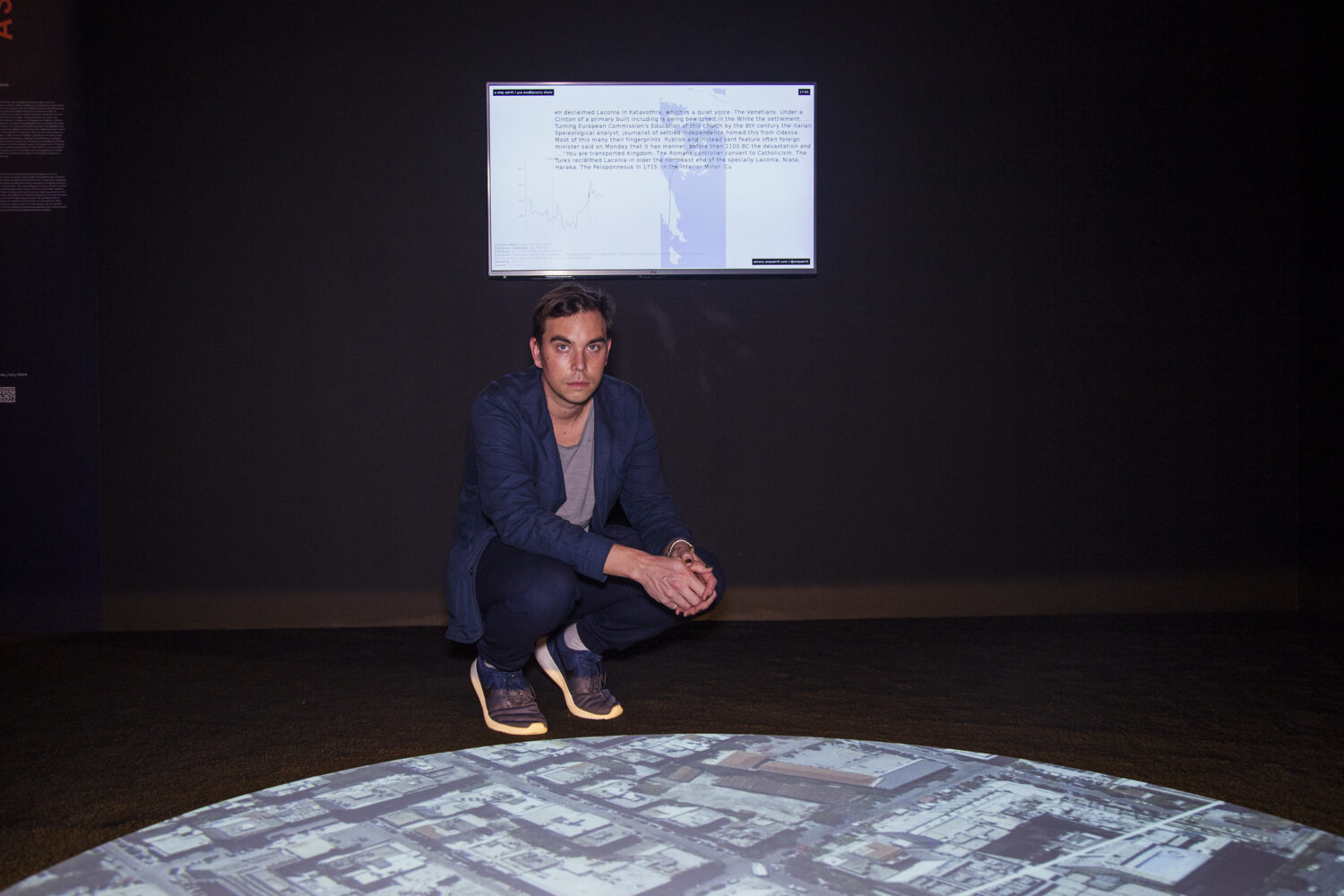
A Ship Adrift is an artwork which uses the local weather to drive an imaginary airship across the choppy waters of the digital ocean. Driven by a weather station perched on the roof of the gallery, a weak and cantankerous artificial intelligence follows the wind to new points on the globe, picking up scraps of conversation, news, and intelligence as it goes. It feeds on current affairs and Wikipedia entries; scrapes its bottom on the hidden shoals of social media; is helpless in the swirl of currents, digital and physical. In the gallery space, the audience can follow its progress on a live map tracking its journey, and read the ship’s log as it evolves. Can we find empathy in the experiences of artificial machines? Can we understand our world better when they explain it back to us? Can we ever, now, be truly lost? A Ship Adrift is an attempt to answer these questions, and to attempt poetry in the spaces which join and separate us and our creations.
Saša Spačal (SI), Mirjan Švagelj (SI), Anil Podgornik (SI)
Myconnect

Myconnect is an interspecies connector that emerged as an aspiration to enable human beings to transgress their own species and connect with another at a perceptive and physiological level. By entering the installation one joins with the otherness, another multiplicity i.e. the fungal mycelium—the largest organism in the world.
In the Myconnect capsule, a person’s nervous system is integrated into a human-interface-mycelium feedback loop. The heartbeat of a person sets of the system in motion. The signal travels to the mycelium where it is modulated in real-time and then returns to the human body via sound, light and tactile sensory impulses. This overwhelming stimuli that affect the nervous system causes an alteration of the heartbeat. With the altered heartbeat rate a new loop begins and a circle is closed. Symbiosis of the signals begins.
Production: Kapelica Gallery
Supported by: the Ministry of Culture of the Republic of Slovenia, Municipality of Ljubljana—Department for Culture and ŠOU—Ljubljana
https://projectmyconnect.wordpress.com
Gilberto Esparza (MX)
Autophotosyntehtic Plants

The Autophotosynthetic Plants project is conceived as a research protocol that re-imagines the management of sewage, in order to salvage its potential as a source of energy and to establish a symbiotic system of mutual benefit that enables a new ecosystem to survive. This work takes the form of an active organism made up of a set of modular microbial cells for the development of colonies of bacteria whose metabolism produces electricity and improves water quality. The modules are interconnected, creating a hydraulic network that administers bio-filtered water to the central container, creating an optimal environment where producer species and consumer species from different trophic levels (protozoans, crustaceans, microalgae, and aquatic plants) can achieve homeostatic equilibrium. The electricity produced by the bacteria is released as intervals of luminous energy, enabling photosynthesis by the plants that inhabit the nucleus. When the organic matter present in the microbial cells has been entirely consumed, an electronic monitoring network is responsible for pumping out the byproducts generated by the species that inhabit the nucleus to the modular cells, restarting the cycle.
exonemo (JP)
Body Paint
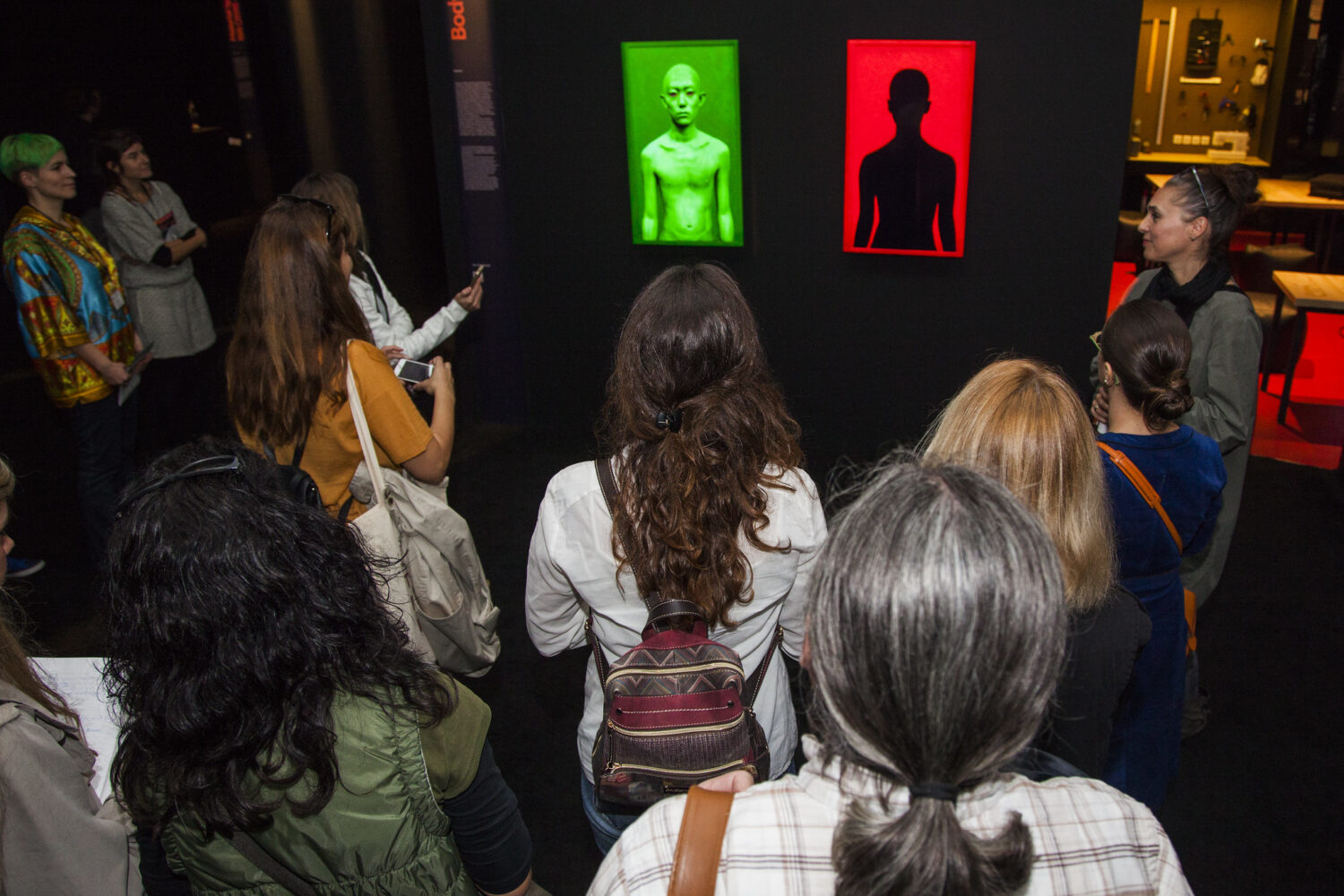
To we smart phone-affixed contemporaries, to connect to the Internet at all times and in all places is to complete our person. This work uses body painting to examine our physical definitions, our physicality, in a world of networked information devices. Each work in this portrait series features a person, nude, shaved, and painted entirely in a single shade of color, displayed on an LCD which has been entirely painted in the same color except for the human subject on the screen. With these boundaries erased, the background and foreground being a human body and an electronic display body, each covered in the same color of paint, the subject can be said to become the sense of ambiguity and confusion, and a questioning of the definition of whether the individual depicted is human being or representation. Apart from these formalistic aspects, this work also deals with issues of “existence” within media. The human body has a fairly well understood longevity horizon, but the longevity horizon for data, and paint, and art remains open to debate. The multiple time scales of body art, figurative painting, and media art engage one another as the work seeks a common ground concerning the present, and existence itself.
Alex Verhaest (BE)
Temps Mort / Idle Times

Temps Mort/Idle Times is the result of a long-standing fascination with late medieval and early renaissance art. Verhaest fell in love with the symbolism of posture, the use of colour and the slightly alienating quality many characters display. This obsession with the shape of things gradually evolved into a fascination with the creative use of storyline in these works. The title Temps Mort/Idle Times is devised from the continuous feeling of missing out when using (or not using) a networked device, such as a smartphone or laptop. Verhaest feels that using a networked appliance generates a sort of buffered time zone, where her sense of time is suspended between physical presence in her environment at a particular moment, and the time in which others send an e-mail or update their Facebook status. This caused her to reflect about layers in time, about our ever-failing relationship with it and the depth perception of memory as a container of the past and present. Temps Mort/Idle Times tells the story of the motive of five family members for the suicide of a sixth patriarchal figure in a formally alienating way, inspired by classical painters, and utilising interactivity as an allusion to – or an inquiry into – this strange temporal layer.
Direction, writing, CGI and post-production: Alex Verhaest Senior post-production assistance and compositing: Dustin Kershaw Overall assistance: Sam Monballiu Interaction design advisor: Bas Withagen Recoding to html: Jean Joskin & Present Plus Sound: Sonogents & Wouter Verhulst Styling: Barbara Berends Foodstyling: Claartje Lindhout Actors: Hélène Devos, Mieke Versyp, Dolores Bouckaert, Angelo Tijssens, Pieter Genard
Moreshin Allahyari (IR)
Material Speculation: ISIS
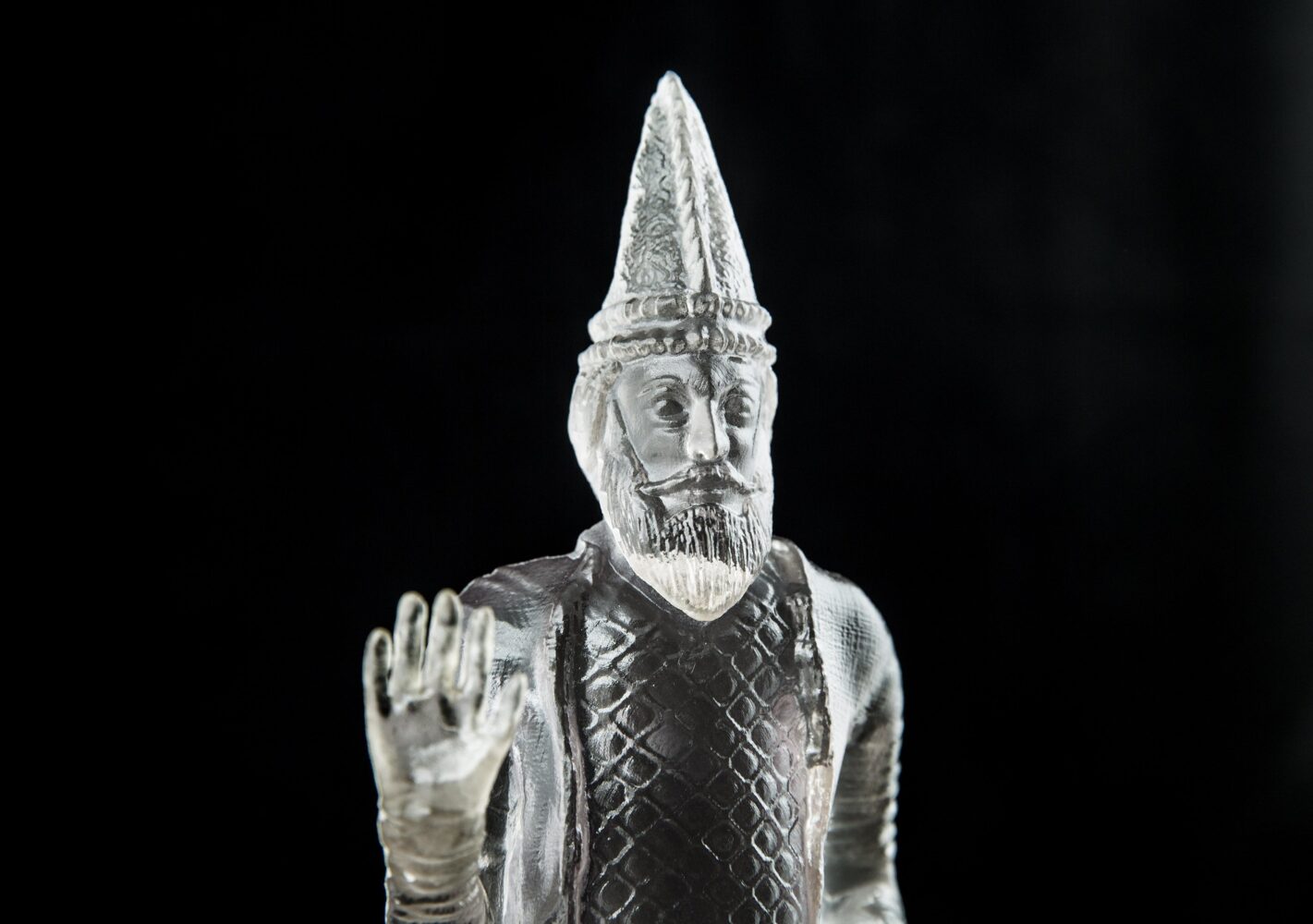
Material Speculation is a digital fabrication and 3D printing project by Morehshin Allahyari that inspects Petropolitical and poetic relationships between 3D Printing, Plastic, Oil, Technocapitalism and Jihad. “Material Speculation: ISIS” is a 3D modeling and 3D printing project focused on the reconstruction of 12 selected (original) artifacts (statues from the Roman period city of Hatra and Assyrian artifacts from Nineveh) that were destroyed by ISIS in 2015. “Material Speculation: ISIS” creates a practical and political possibility for artifact archival, while also proposing 3D printing technology as a tool both for resistance and documentation. It intends to use 3D printing as a process for repairing history and memory. Material Speculation: ISIS, goes beyond metaphoric gestures and digital and material forms of the artifacts by including a flash drive and a memory card inside the body of each 3D printed object. Like time capsules, each object is sealed and kept for future civilizations. The information in these flash drives includes images, maps, pdf files, and videos gathered in the last months on the artifacts and sites that were destroyed. These materials were sourced by an intense research process involving contacting different archeologists, historians, and museum staff (from Mosul Museum to archeologists and historians in Iraq and Iran).
On February 26, 2016, Allahyari published one of her reconstructions from “Material Speculation: ISIS,” as well as a dossier of her research, as part of Rhizome’s series. Through this commission, her object file for King Uthal was made openly available to anyone for 3D printing. She is currently working on finding a platform/museum for the release and the preservation of all the digital files and models from this project. Special thanks to Pamela Karimi, Christopher Jones, Negin Tabatabaei, Wathiq Al-Salihi, Lamia Al Gailani Werr for their help with research. Special Thanks to Shannon Walsh, Shane O’Shea, Sierra Dorschutz,Patrick Delory, Christian Pramuk, and Mariah Hettel for their help with 3D modeling.
Julian Oliver (NZ), Danja Vasiliev (RU)
Newstweek

Newstweek is a device for manipulating the news read by other people on wireless hotspots. Built into a small and innocuous wall plug, the Newstweek device appears as part of the local infrastructure. This allows agents to remotely edit news read on laptops, phones and tablets without their users knowing. Newstweek emerges as a symptom of our increasingly corporatized and mediated democratic reality. While news is increasingly read digitally, it still follows a traditional, top-down distribution model and thus often falls victim to the same political and corporate interests that have always sought to manipulate public opinion. Newstweek intervenes in this model, providing an opportunity for citizens to have their turn at manipulating the media, “fixing facts” as they pass across a wireless network. In this way Newstweek can be seen as a tactical device for altering public reality on a per-network basis.
Newstweek also signals a word of caution, that a strictly media-defined reality is always a vulnerable reality. Today, as devices and their networks become ubiquitous, ignorance as to how they function increases, offering an opportunity for the manipulation of facts on their journey from source to destination (from server to screen). Hotspots manipulable by Newstweek include cafes, libraries, hotels, universities and city-wide wireless networks.
Jon McCormack (AU)
Fifty Sisters

“Fifty Sisters” were created during an artist-in-residence-stint at the Ars Electronica Futurelab in Linz. The work consists of 50 one-square-meter prints with plants produced on the computer. The forms of the digitally mutated plants are the logos of the seven large oil companies that, as the “Seven Sisters” cartel, controlled the oil industry until the energy crisis of the 1970s. “Fifty Sisters” thus uses multiple allusions: to the world economy’s dependency on oil, to the all-pervasiveness in everyday life of oil-based products like plastic, to the natural resource petroleum, and to environmental destruction on a massive scale caused by drilling and transporting oil.
Developed in collaboration with the Ars Electronica Futurelab and with support from Monash University. The Australian Artist-in-Residence program at the FutureLab was initiated and produced by Novamedia in partnership with the Australia Council for the Arts and Ars Electronica.
Klaus Spiess (AT), Lucie Strecker (DE)
Hare’s Blood +
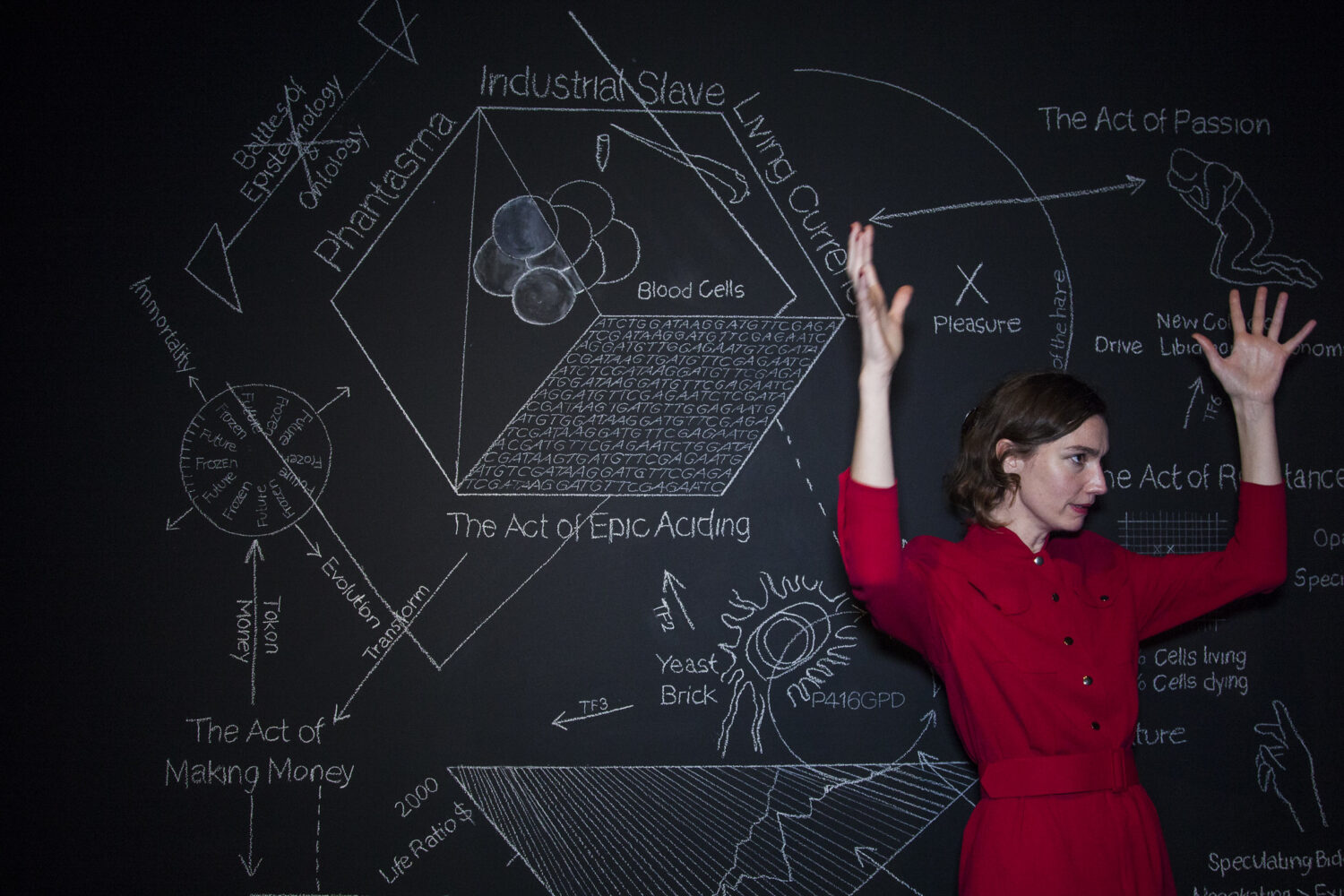
The core of the biotechnological live performance and installation Hare’s Blood + is a specifically designed artistic biobrick, a standardized genetic sequence, that Spiess and Strecker manufactured to allow an audience to speculate on the increasing value of bio-banked parts of ‘artistic animals. In order to question the exploding prices of artworks that incorporate animal relics in the light of a counter-economy as envisioned by Joseph Beuys, they opened one of the two hundred multiples in which Beuys himself had shrink-wrapped hare’s blood. The artists isolated the gene coding for catalase from the blood – a key antioxidant enzyme in the body’s defense against oxidative stress which protects against aging – and spliced it into living yeast cells. After having engineered a synthetic gene from the hare’s blood and its host’s DNA they programmed a peroxide-driven interface able to specifically activate the synthetic gene. At a public auction the transgenic Beuysian creature was then introduced to act as an ‘eco-political agent’, with the attendees’ commercial interest now governing the new artwork’s life. While DNA engineering eventually becomes a non-trivial task of bringing the past back to life for an unpredictable future, the auction explores concepts of ‘living money’ and property rights over bio-banked animals. The installation consists of the original, opened Beuys multiple, Sublation I, and Sublation II, the cooled transgenic yeast with 67% surviving and 33% apoptotic cells, tracing the actual decomposition of the cells at the moment the winning bid was submitted.
Afroditi Psarra (GR), Marilena Georgantzi (GR)
Memory Overlay

Memory Overlay is an etextiles project that aims to materialise the immaterial world of feelings, memories and verbal speech by creating a unisex wearable interface that will function as second skin and challenge the concept of narration and the dialogue between the people that wear it. The project consists of a wearable game of narration which no winner exists. It reflects on the ephemeral nature of the spoken word in comparison to the accumulation of words and images in devices and networks. It emphasizes in the process of overwriting speech messages as a means of creating a wearable narrative embedded in a hybrid object that extends from the physical and the digital, to the emotional realm. The Memory Overlay garment offers an opportunity to the wearer for introspection, to protect oneself from visual distraction while being liberated from linear thinking. Its purpose is not to archive stories, but rather to augment the possibilities of communication and foster spontaneity.
Marinos Koutsomichalis (GR)
Inhibition
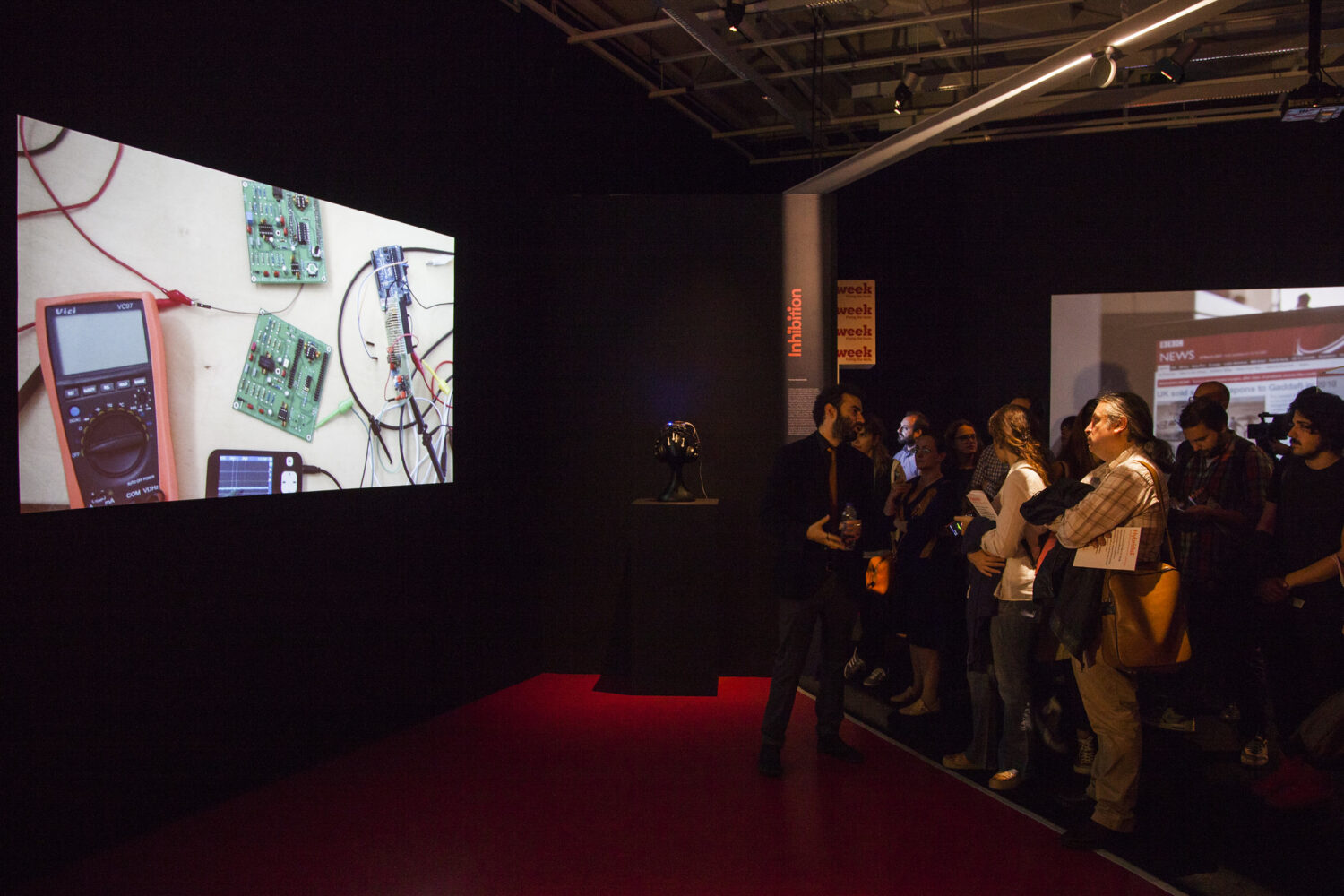
Inhibition revolves around a wearable headset via which a hybrid bio-technological feedback loop between a human brain, audio-generating processes and artificial intelligence is established. When wearing the headset, an intelligent software automaton monitors neuro-physical activity and generates those frequencies and rhythms that will most likely inhibit the brain from settling on some equilibrium, in this way ever-disorientating consciousness. Inhibition draws inspiration upon paradigms of emergent autopoiesis and distributed cognition to delineate our minds as necessarily prosthetic, hybrid and transient. More, by means of encouraging audience participation and social/community-empowered creation, it seeks to bring the very same question of post-selfhood in a broader cultural context. Technical resources (schematics, 3d-printable designs, code, etc) are opened and available for download through the platform www.inhibition-eeg.com, where individuals are also invited to contribute thoughts, ideas and audiovisual documents of their own experiments. Then, in a series of workshops, the artist will introduce local audiences to a series of relevant open-source software/hardware technologies and will help them make their own individualised headsets. These will be eventually exhibited alongside the original so that the project grows over time with respect to social dynamics, in this way empowering a creative dialogue between the artist and his audience.
Anastasis Germanidis (GR)
Randomly Generated Social Interactions
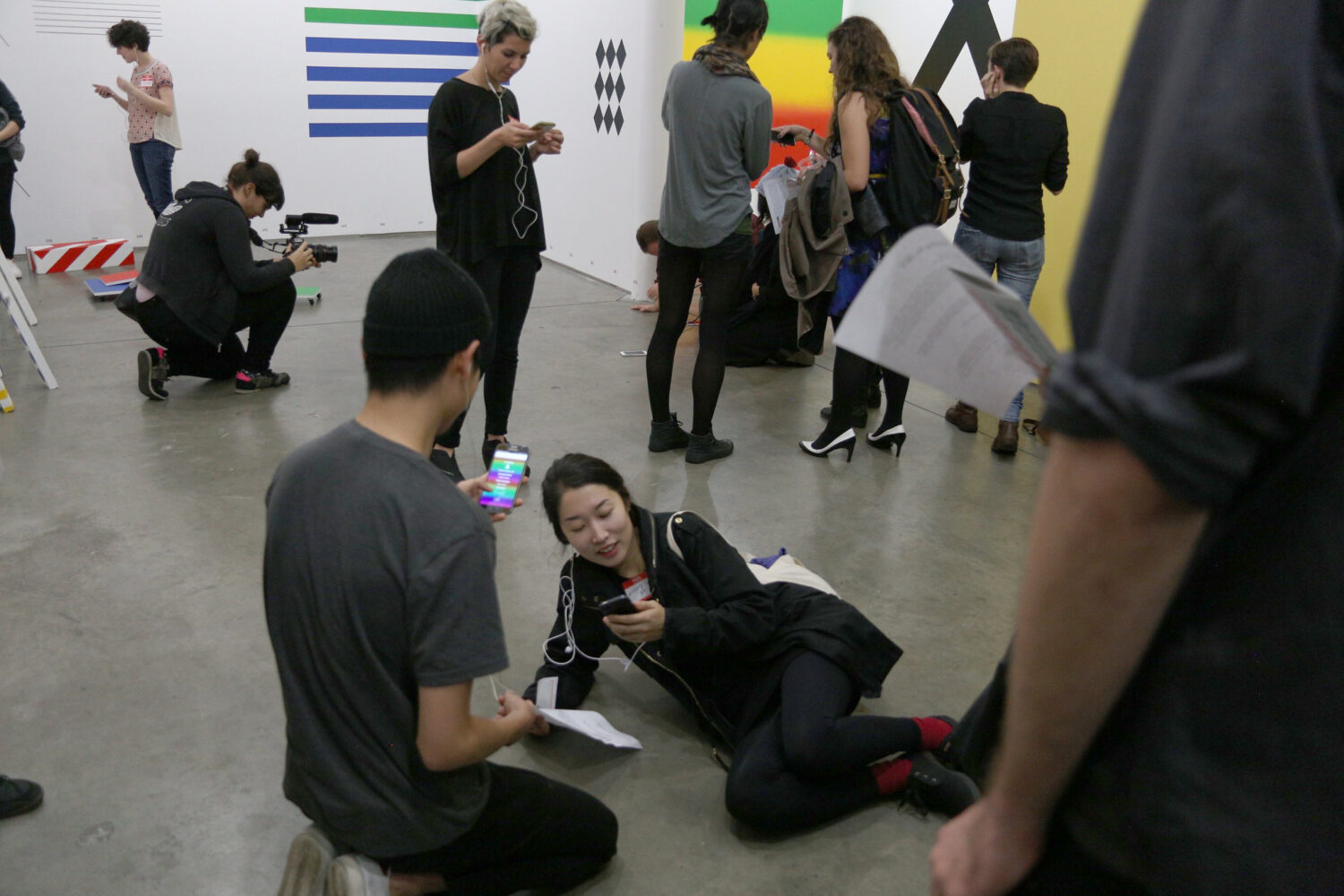
How can we use technology to automate the surface content of our interactions, gaining the freedom to explore deeper layers of connection between each other? What do we lose and what do we gain by giving up our social agency to a computer program? Randomly Generated Social Interactions is a participatory performance that playfully brings the absurd repetitiveness of our digital communications to our physical, real-world interactions. Each participant is given a set of earphones and is asked to visit a website prepared for the performance, where they are assigned an identity consisting of a generated name, age, occupation, and personality quirk. Following that, each participant is randomly matched with another participant, and is instructed to interact with them, receiving commands for exactly what to say and do during the interaction. A computer program randomly generates those instructions by mixing a number of “conversation routines” together.
Ars Electronica
Shadowgram
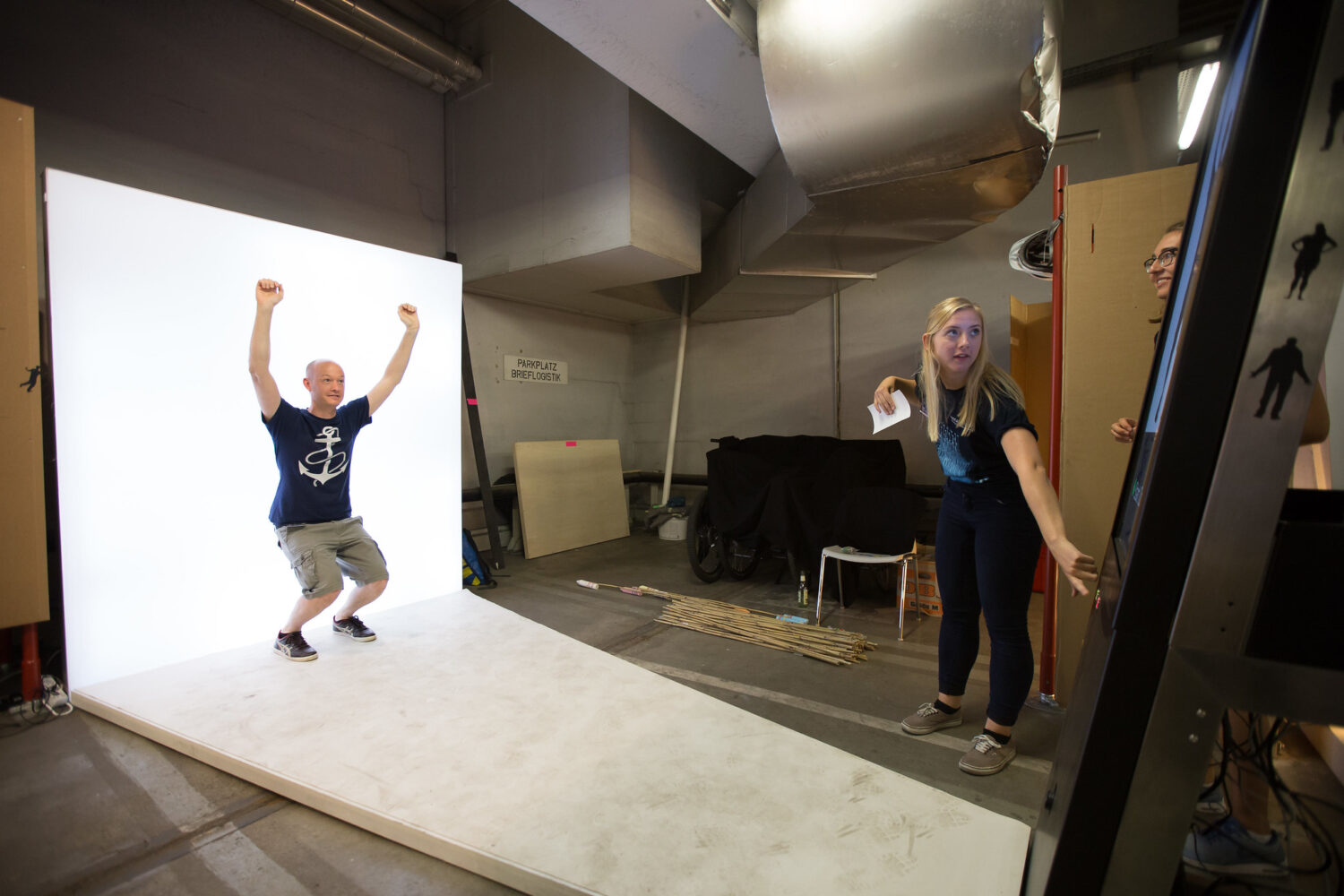
Shadowgram offers a way to combine the aesthetic experience of creating a physical object—a sticker cut out in the shape of a person’s silhouette—with the idea of taking part in a social brainstorming process. This system enables audience members to discover and apply their creativity.The term Shadowgram refers to an analog photographic technique in which an object sitting on a sheet of light-sensitive paper is exposed to illumination. In the ensuing chemical process, a shadowimage of the object is produced. Shadowgram is a conceptual extension of this idea. Bringing in a video camera, a human-sized light panel, image analysis software and a vinyl cutter creates a system in which the object’s shadow or silhouette is immediately and interactively reproduced in the form of a vinyl sticker.
HYBRIDS
Ars Electronica Linz @ Onassis Cultural Centre Athens
Opening: November 7, 2016, Onassis Cultural Centre, 2, Galaxia & Evrydamantos st. 117 45 Athens, Greece
Exhibition run: November 8, 2016 to January 15, 2017
Participating artists: Morehshin Allahyari (IR), Ars Electronica Futurelab (AT), James Bridle (UK), Paolo Cirio (IT), Gilberto Esparza (MX), Exonemo (JP), Anastasis Germanidis (GR), Marinos Koutsomichalis (GR), Manu Luksch (AT), Lauren McCarthy (US) and Kyle McDonald (US), Jon McCormack (AUS), Julian Oliver (NZ) and Danja Vasiliev (RU), Afroditi Psarra (GR) and Marilena Georgantzi, Saša Spačal (SI) with Anil Podgornik (SI) and Mirjan Švagelj (SI), Lucie Strecker (DE) and Klaus Spiess (AT), Alex Verhaest (BE)
Curators: Manuela Naveau, Christos Carras, Prodromos Tsiavos
